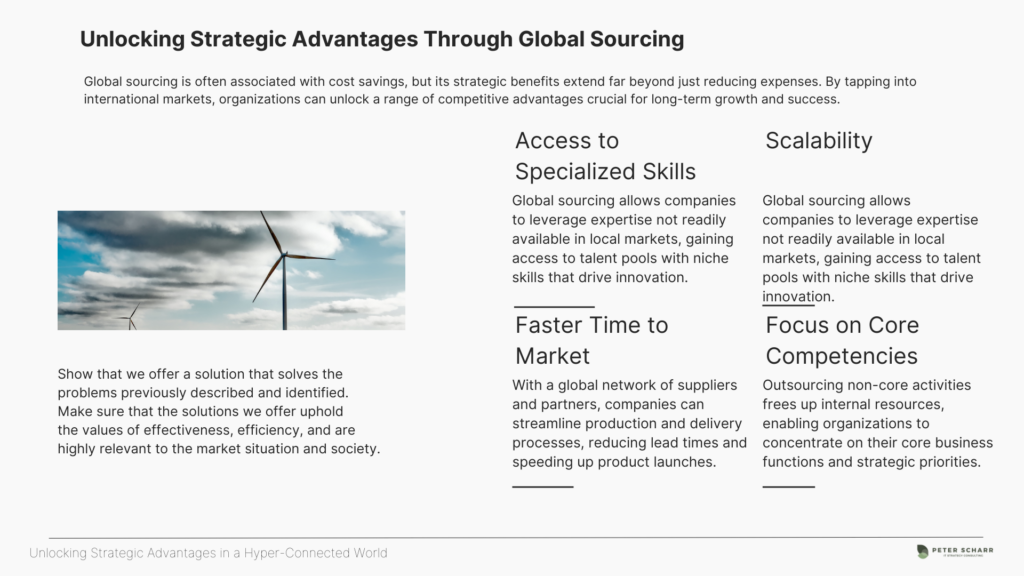Understanding Global Sourcing – Foundations and Key Concepts
In today’s hyper-connected world, businesses are no longer limited by geographic boundaries. Enter global sourcing, a practice that allows companies to tap into resources, talent, and materials from all corners of the globe. But what exactly is global sourcing, and why has it become such a vital part of modern business strategy? Let’s dive into the basics to find out.
What is Global Sourcing?
At its core, global sourcing refers to the process of procuring goods, services, or resources from international markets. Rather than relying solely on local suppliers, businesses look abroad to find the best value, quality, or expertise. This strategy helps companies stay competitive by accessing a wider range of suppliers and reducing costs.
A Brief History of Global Sourcing
While global sourcing might seem like a modern concept, its roots go back centuries. Long before the age of the internet, traders navigated the Silk Road and the oceans to source materials like spices, textiles, and precious metals from distant lands. However, it wasn’t until the late 20th century, with advances in communication and transportation, that global sourcing as we know it today really took off. The emergence of globalization has played a key role in this evolution, breaking down trade barriers and fostering interconnected economies.
Key Terms to Know
To better understand global sourcing, it’s helpful to familiarize yourself with a few key terms:
- Supply Chain Management: This involves overseeing the entire flow of goods and services, from raw materials to finished products. Global sourcing is often a crucial part of effective supply chain management.
- Outsourcing: When a company contracts out a portion of its operations—like manufacturing or customer service—to a third-party provider, often located abroad, it’s engaging in outsourcing. This is a common part of global sourcing strategies.
- Offshoring: Offshoring is similar to outsourcing but focuses on moving business operations to another country, usually to take advantage of lower labor costs or specialized expertise.
How Global Sourcing Has Evolved
With the rise of technology and digital platforms, global sourcing has become more sophisticated than ever before. Businesses can now connect with suppliers in real time, manage logistics more efficiently, and even automate parts of their supply chain. Moreover, the ability to source from multiple regions creates flexibility, reducing the risk of relying on a single supplier or market.
Through global sourcing, companies are not just cutting costs—they’re also gaining access to innovation and new markets. However, this strategy also comes with challenges, such as ensuring quality control and navigating complex international regulations. We’ll cover these topics in more detail as we explore the advantages and risks of global sourcing in the sections to come.
The Strategic Benefits of Global Sourcing: Cost Efficiency and Beyond
When people think about global sourcing, the first benefit that often comes to mind is cost savings. And yes, finding lower-cost suppliers in different regions can significantly reduce expenses. But the truth is, global sourcing offers so much more than just cost efficiency. By thinking strategically about global sourcing, businesses can unlock a wide range of advantages that go beyond the bottom line.

Access to Specialized Skills and Expertise
One of the biggest benefits of global sourcing is the opportunity to collaborate with experts all around the world. Different regions often have specialized talent pools and cutting-edge technologies that might not be readily available in your local market. For example, many companies turn to countries like India for IT services or Germany for advanced manufacturing. By tapping into these specialized skills, businesses can enhance their products or services and stay ahead of the competition. In fact, according to Forbes, global sourcing is helping companies leverage highly skilled global talent to drive innovation.
Scalability and Flexibility
Another key advantage of global sourcing is scalability. As businesses grow, their sourcing needs often grow too. Global sourcing allows companies to quickly scale up or down based on demand without the limitations of local supply chains. This flexibility is particularly valuable in industries where market conditions can change rapidly. By working with suppliers in multiple regions, businesses can adjust their operations more efficiently and respond to market fluctuations with ease.
Faster Time to Market
Time is money, and in today’s fast-paced world, getting products to market quickly is crucial for success. Global sourcing can speed up the time to market by enabling businesses to source materials or components from locations that offer faster production or delivery times. For example, companies that need to meet tight deadlines might source from suppliers closer to the target market to reduce shipping delays. According to a report by Harvard Business Review, companies are increasingly optimizing their global sourcing strategies to reduce lead times and improve delivery speed.
Focusing on Core Business Functions
Finally, global sourcing allows businesses to focus on what they do best. Instead of spending time and resources managing every aspect of production or service delivery, companies can outsource certain tasks to experts abroad. This frees up internal teams to concentrate on core business functions like product development, marketing, and customer service. In the end, outsourcing non-core activities can help businesses operate more efficiently and stay agile in a competitive environment.
In short, while cost savings may have been the original driver of global sourcing, today’s businesses are looking at the bigger picture. By leveraging global sourcing strategically, companies can gain access to specialized skills, scale more effectively, bring products to market faster, and focus on their strengths—helping them stay competitive in an increasingly interconnected world.
Challenges and Risks: Navigating Uncertainty in Global Sourcing
Every opportunity comes with its share of risks, and global sourcing is no exception. While it offers a multitude of strategic advantages, businesses must also be prepared to face potential challenges. From geopolitical uncertainties to maintaining quality control, there are several factors that can disrupt the smooth flow of global sourcing. But fear not—understanding these risks and having the right strategies in place can help you navigate these uncertainties effectively.
Geopolitical Risks and Trade Barriers
One of the most unpredictable challenges in global sourcing comes from geopolitical tensions and changing trade policies. Tariffs, trade wars, and political instability can all affect the flow of goods across borders. For instance, a sudden imposition of tariffs between countries could make sourcing from a once-cost-effective region much more expensive. It’s important to stay updated on international trade policies and maintain strong relationships with multiple suppliers across different regions to mitigate this risk. Diversifying your supplier base ensures that if one country’s political situation becomes unfavorable, you have alternatives to fall back on.
Supply Chain Disruptions
Global sourcing often means managing a complex supply chain that spans multiple countries. Natural disasters, pandemics, or even logistical issues like port congestion can cause significant delays or disruptions. The COVID-19 pandemic, for example, exposed how quickly global supply chains can be disrupted. To manage this risk, businesses need to build more resilient supply chains by incorporating buffer stock, working with multiple suppliers, and leveraging digital tools for real-time visibility. According to McKinsey, creating a more resilient supply chain can reduce the impact of future disruptions and help businesses recover faster.
Maintaining Quality Across Borders
Ensuring consistent quality is another challenge in global sourcing. Managing suppliers from different countries can make it difficult to monitor production standards, especially if there are language barriers or cultural differences. Variations in manufacturing practices and quality control systems across regions can lead to discrepancies in the final product. To mitigate this, businesses should establish clear quality standards, conduct regular audits, and invest in long-term partnerships with trusted suppliers. Implementing strong quality assurance processes can help maintain product consistency, even when sourcing from multiple regions.
Cultural and Communication Barriers
Working with suppliers from different cultures can present unique challenges in communication and collaboration. Misunderstandings can arise from differences in business etiquette, negotiation styles, or even language barriers. For instance, while some cultures may value direct communication, others may have a more indirect approach that could lead to confusion. To overcome these challenges, it’s important to invest in cultural training, foster open communication, and use technology to bridge any language gaps. Building strong, respectful relationships with international partners is key to long-term success in global sourcing.
Strategies for Risk Mitigation
While global sourcing does come with risks, these challenges can be managed with the right strategies in place. Diversify your supplier base to reduce dependence on any single region, invest in technology to improve supply chain visibility, and maintain clear and consistent communication with your partners. By being proactive and prepared, you can turn potential risks into opportunities for improvement and growth. As Forbes highlights, businesses that take a proactive approach to risk management in global sourcing are better positioned to handle uncertainty and thrive in the long term.
In the next section, we’ll explore how technology is playing an increasingly important role in addressing these challenges and optimizing global sourcing practices.
Until next time,


